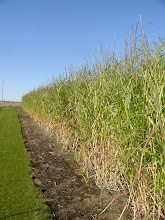People on all sides of the ethanol industry are talking about the 10% blend wall. Is the 10% blend wall really the a problem or are we not looking at it from the correct perspective. It is a significant accomplishment that we are at the point of replacing 10% of the US need of gasoline with ethanol. We should celebrate this fact and look at the opportunities going forward.
I read a recent article by Robert Rapier which jogged my thinking a bit. Robert in his usual fact based thinking was comparing the cost of the $4 billion ethanol pipeline to increasing the utilization of E-85 in the Midwest to displace fuel usage instead. The lights turned on in my head and I started thinking about how this could really affect the ethanol markets and how could we encourage this new strategy to quickly provide demand for ALL ethanol produced. Even the sugar cane ethanol!
Here are some rough numbers just to prove illustrate the point. If we say that annual gasoline usage in the US is about 130 BGY (billion gallons per year) and we currently have a 10% maximum we have a maximum ethanol blending of 13 BGY. If we say 10% is going to be the limit for non flex fuel vehicles in the US and we are going to increase the biofuels usage to 18 BGY by 2014 as projected in the RFS2 where does the growth come from? Increasing the overall blend maximum to 15% will get us there. But we have an alternative which may prove to be better in the long run.
What if we did not increase the blend ratio to 15% and started adopting a strong E-85 strategy? OR maybe even better yet we did both? We could significantly shift the demand upward by placing incentives in the market. We could develop the 36 BGY demand by 2022 as projected in the RFS2 by replacing less than 25% of our current needs with E-85 even if we left the remainder of the fuel blended at 10%.
The current ethanol blenders credit is going to expire at the end of this year. It is already getting cut back. Why don't we redirect those funds to foster the development of E-85 blending and infrastructure. What if we cut the E10 blenders credit but left the credit the same if ethanol was used for E85? What if we let people who invested in ethanol blending and distribution equipment accelerated tax benefits for their investment? What if we required auto manufacturers to make all gasoline vehicles flex fuel and we subsidizes each vehicle a little? We could put this money not spent on the E10 blending to good use and have the infrastructure in place to move into more renewable fuels.
This would all be done with the limits on corn ethanol staying the same at 15 BGY. We would drive the demand so far past our current corn capacity that we may be able to eliminate the import tariffs on sugar cane ethanol.
This brings about the possibility of halting the increase in crude oil usage in the near future. Isn't that what we really want to do? Additional developments in drop in replacement fuels may actually allow us to REDUCE the use of crude oil to much lower levels.
There are many ways to win. We need to use what we have and move forward. Pontification on the ultimate solution prevents us from making good changes today.
Tuesday, August 3, 2010
Subscribe to:
Post Comments (Atom)

No comments:
Post a Comment